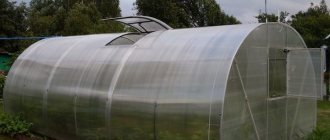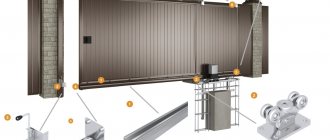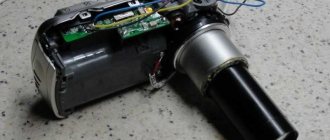Why is greenhouse ventilation needed?
A greenhouse always poses several tasks for a summer resident - how to save heat, protect plantings from unfavorable climatic conditions and weather, and ventilate this structure in time to get rid of excess moisture and slightly reduce the air temperature in it. But few people think about why it is necessary to closely monitor the microclimate in the greenhouse and ventilate this structure in a timely manner.
Thermal drive-DV with bracket and closer (gas lift)
The main reasons for the need to ventilate greenhouses.
- In greenhouses where ventilation is poorly organized, there is a high level of humidity, which is why pathogenic microorganisms actively multiply.
- Not only bacteria, but also various pests love humid and stuffy conditions.
- Plants need fresh air to “breathe,” or rather, for the process of photosynthesis.
- For plant organisms, excessively high temperatures are very harmful - they begin to dry out, “burn” and eventually die.
- Properly organized ventilation will provide an excellent microclimate, which will have a positive effect on the well-being of plants and the quality of the harvest.
- Good ventilation allows you to harden plants and improve their immunity.
- Ventilation will help harden the seedlings standing in the greenhouse and accustom them to independent life in the ground.
- Air exchange and ventilation are necessary for the process of pollination of plants.
Attention! Air temperatures above +40 degrees and the scorching sun are very harmful to plants. Some crops even die from excess heat. Remember that the air temperature in a closed greenhouse can rise very quickly. A thermometer installed inside the structure will help monitor its (temperature) level.
To make plants and flowers grow quickly, take care of ventilation
It is important not just the presence of ventilation, but also its proper organization. Any haphazardly installed vents will clearly not be enough - as a rule, a primitive ventilation system that is convenient for humans is not suitable for plants.
Ventilation is especially important for polycarbonate greenhouses. In a conventional greenhouse, plants have at least a small chance that fresh air will penetrate through the cracks in the structure. From the same point of view, polycarbonate greenhouses can be called practically airtight.
Ceiling automatic ventilation
However, you need to be very careful with ventilation - heat-loving greenhouse crops may die due to drafts and cold air. That is why the greenhouse must be closed at night even in warm weather - frost can strike without warning and ruin all your work.
In order to properly ensure ventilation and air circulation in the greenhouse, gardeners need to closely monitor weather conditions, and also constantly be at their summer cottage in order to be able to open and close the doors and windows in the greenhouse structure. And this is not always convenient, for example, for a working person. But even this difficult situation now has a solution. You can purchase a thermal drive for a greenhouse, which will provide autonomous ventilation of the structure, doing this troublesome work for you.
Universal automatic greenhouse ventilator for side and dome vents
Types and design features
Thermal actuators for industrial greenhouses look approximately the same. A completely different matter is homemade devices, for the manufacture of which folk craftsmen have adapted a wide variety of available materials.
Since buying and installing a ready-made thermal drive is not difficult, we will consider the main types of homemade structures:
- From a gas shock absorber: in this case, automobile oil is used as the working fluid. For manufacturing you will need a shock absorber piston, two taps and a metal pipe in which the oil will be located. The shock absorber rod is attached to the window. A tap for filling oil is attached to one side of the pipe, and on the other side there is a similar tap through which the oil will be drained. The bottom of the gas spring is cut off and tightly attached to the pipe. By attaching such a device to the window, you will be sure that ventilation will be carried out on time: the oil, expanding, will lift the rod and return it to its original position when it cools.
- From a plastic bottle: This budget option is great for small greenhouses with only a few windows open. To make it, you will need two plastic bottles (5 and 1 liter), some black plastic film, a piece of wooden board, two pipes and a meter-long PVC pipe of small diameter. A hole is drilled in the center of the bottom of a clean and dry five-liter bottle. A pipe is inserted into it and connected to a PVC pipe. To ensure that the container is completely sealed, it is better to cover all joints with thermal paste. The remainder of the tube coming from the bottom is inserted into a liter bottle. It is better to do this through a hole drilled in the roof. Next, you need to wrap a large container in black film and hang it from the ceiling. A small bottle is hung next to the window. A wooden board is nailed to the transom with one edge, and the other is placed over a liter bottle so that it crumples. As a result of heating the large container, warm air will begin to flow into the small bottle. Under the influence of expanded oxygen, it will straighten and lift the board, which will push the frame out.
- From cylinders and a ball: another simple type of homemade device for ventilating a greenhouse. To make it you will need a small wooden box with a lid, a ball, a hose, a board and two cylinders. A hose is attached to the communicating cylinders, and its length must correspond to the height of the greenhouse. The second end of the hose is put on the nipple of the deflated ball. The ball must be placed in the box and the lid closed. We nail a board to the lid and connect it to the transom. The cylinders are suspended from the ceiling, and the box with the ball is placed under the window. The cylinders, heating up, will begin to supply warm air through the hose to the ball. He will puff up, open the lid, and the nailed board will open the window.
All these types of homemade devices for a greenhouse are quite simple to manufacture, but do not forget that they do not have a long service life, especially for structures made from bottles. Therefore, if you want to make a more reliable structure, you will have to use stronger materials.
Automatic ventilation of greenhouses: how it works, or What is a thermal drive for greenhouses
In order for the plants in the greenhouse to feel good, it is necessary to maintain the correct temperature, humidity and fresh air flow. To solve these problems, you should install vents with closers for greenhouses. With their help, you can regulate the microclimate in an indoor garden. With proper ventilation, harmful insects and microorganisms will not multiply in the greenhouse, and the temperature will be maintained at optimal levels for the plant.
In order for this system to work smoothly and without delay, the windows must also be equipped with automatic machines for ventilating greenhouses. Due to the ability of warm air to rise, vents should be placed at the top of the greenhouse. Their number on average is 2-3 per structure 6 m long. It should be remembered that they must be placed approximately evenly over the entire area in order to ensure equal movement of air flows, prevent drafts and slamming of frames when there is a gust of wind.
You can do without an automatic ventilation system for greenhouses, but its presence will greatly facilitate the gardener’s work and allow him to do other work.
Device classification
According to their mechanism of action, thermal actuators come in several types:
Electrical
In such systems, the actuator is driven by an electric motor. The signal to turn on the motor is supplied by the controller, which receives information from the temperature sensor.
The main advantages of electric drives include sufficiently high power and the ability to create intelligent systems that include a wide variety of sensors that make it possible to correctly determine the ventilation mode.
The disadvantages of electric drives are the dependence on power supply and the relatively high cost.
In addition, the humid atmosphere of the greenhouse does not have a favorable effect on the operation of any electrical appliances.
Pneumatic
Pneumatic systems work by supplying heated air from a container to the actuator piston. When the sealed container heats up, expanded air is supplied to the piston, it begins to move and this helps to open the window.
If the temperature drops, the air inside the system is compressed and the piston pulls in the opposite direction, closing the window. Despite the simplicity of this type of thermal drive, it is quite difficult to make it yourself.
To do this, you will need to ensure complete sealing of the container and inside the piston, which is not easy.
Moreover, the ability of air to be easily compressed greatly complicates the task, which can lead to loss of system efficiency.
Bimetallic
The operating principle of such devices is based on different coefficients of thermal expansion for different metals.
If metal plates are fastened together, then when heated, one of them will become larger in size than the other.
As a result, the resulting distortion is used as a source for mechanically opening the window.
The advantage of this drive is its autonomy and simplicity, the disadvantage is that the required power is not always required.
Hydraulic
The hydraulic thermal drive mechanism operates by changing the balance in the weight of a pair of containers, between which the liquid moves.
Accordingly, liquid moves between vessels due to changes in air pressure during heating and cooling.
The advantage of such a system is its high power in the complete absence of electricity. It is much easier and cheaper to assemble such a design with your own hands than other drives.
Do-it-yourself thermal actuator for a greenhouse
You can make a thermal actuator from parts of an old office chair. Actually, from the latter you only need one part - the cylinder, which is responsible for raising and lowering the seat. It consists of two rods - steel and plastic. So, let's begin.
Office chair cylinder
Step 1: Using a vice, remove the plastic rod. Inside you will find a pin made of strong steel.
Example of a cylinder (gas lift) device
Step 2. Take a metal rod, preferably steel, 8 mm in diameter, and clamp it with a reliable vice so that it protrudes about 6 cm.
Step 3. Place the cylinder on the rod, press firmly and completely remove the air from it.
Step 4. Cut off the cylinder that has a taper using a regular grinder and press out the metal rod from it. At the same time, do not spoil the smooth surface and the rubber element present on the rod.
Step 5. Make an M8 thread on the edge of the rod, and return the sleeve that was inside the cylinder to its place.
Step 6. Remove the rubber rings from the aluminum piston.
Step 7. Insert the piston into the sleeve that is inside the cylinder part and remove it from the cylinder. Try not to damage the oil seal with your actions. Screw on the M8 nut - it is necessary so that the piston does not accidentally fall inside the structure.
Nut M8 galvanized
Step 8. Insert the aluminum piston into the valve seat. Weld a metal pipe to the edge of the cylinder on the cut side as tightly as possible. Screw an extended M8 nut onto the thread on the rod.
Step 9. Connect the mechanism to the sash control levers and fill with regular motor oil. When doing this, do not forget to remove the air. To make this process more convenient, install a plug on one side of the pipe and a ball valve on the other.
A simple option - a thermal drive circuit for automatic ventilation of glass jars
Homemade bellows-based ventilation device
Types and principle of operation of automatic ventilation of greenhouses
The operating principle of any automatic ventilation of greenhouses with a thermal drive is based on the opening and closing of the window as a result of temperature readings in the room. There are several types of devices for ventilating greenhouses. Each of them differs in the physical principle underlying the operation of the device, and has its own advantages and disadvantages.
Electronic thermal drive
The system consists of fans located in the upper part of the greenhouse and a thermal relay with sensors that control their operation. This is one of the most convenient and effective ways to regulate temperature.
The advantages of using an electronic thermal drive are:
- rationality;
- precise temperature control, which does not have inertia;
- wide power range that fits any size of greenhouse;
- ability to use in greenhouses of any design.
The disadvantages of an electric ventilator for greenhouses is its complete dependence on electricity and its uninterrupted supply. To eliminate this drawback, you can install a backup power source in the form of a battery, generator or solar battery storage.
Did you know? The first greenhouses appeared in Ancient Rome. The Romans planted plants in carts on wheels. During the day they were placed in the sun, and at night they were hidden in warm rooms.
The principle of operation of a plate made of different metals
Much less commonly used is an auto-ventilator for a greenhouse, the operating principle of which is based on the ability of different metals to react differently to temperature changes. This device is called a bimetallic system. It consists of two plates consisting of metals with different coefficients of linear expansion. When heated, the plates bend in one direction and open the window; when cooled, they bend in the other direction, closing it.
Advantages of this system:
- complete autonomy and independence from power sources;
- ease of installation;
- can be used for a long time;
- cheapness.
Disadvantage of the system:
- inertia. If the heating is insufficient, the window will not open;
- low power. Suitable for light frames only;
- the difficulty of selecting metals that can expand at the temperature required for plants.
Did you know? Greenhouses, similar in appearance to those of today, appeared in the 13th century in Germany. Their creator is considered to be Albert Magnus, whom the Catholic Church recognized as a sorcerer. And the construction of greenhouses was prohibited by the Inquisition.
Features of the design based on hydraulics or pneumatics
The thermal drive system for an automatic greenhouse is based on a hydraulic or pneumatic operating principle. The difference between these principles is in the working fluid: liquid or air. You can make the system yourself or buy it in a store.
The device consists of a cylinder filled with a special liquid and a rod that moves under the force of expansion or compression of this liquid. At a temperature of 23 degrees, the liquid begins to expand and pushes the rod with a force of more than 20 kg, opening the window. The system should close under its own weight as the rod retracts. If the window has a structure that needs to be closed, then either a spring or a similar reverse action mechanism is offered for this.
Such a system has a number of advantages:
- reliability and durability;
- independence from power source;
- easy to attach to the frame. All you need is a screwdriver or screwdriver;
- sufficient power for any type of frame.
Disadvantages of a hydraulic ventilation system:
- inertia of the process. When the temperature drops sharply, closing is slow;
- the temperature is monitored only at the location where the system is mounted;
- high cost, therefore not economically viable for small greenhouses.
Advantages and disadvantages
Among the advantages that a hydraulic cylinder used to provide ventilation of greenhouse premises in automatic mode has, the following should be highlighted.
- To operate such a device, it does not need to be connected to a power supply.
- A simple design scheme makes it quite easy to make a hydraulic cylinder for a greenhouse with your own hands.
- Such a device does not require constant maintenance.
An automatic ventilation system based on a hydraulic cylinder, despite some disadvantages, is quite often used in personal greenhouses
Naturally, such a device for automatically ventilating greenhouses also has disadvantages.
- When installing such a device on a window frame that rotates on a vertical axis, it is necessary to additionally use a return spring, since such a frame will not lower under its own weight when the volume of working fluid in the hydraulic cylinder decreases.
- If the air temperature drops sharply outside the greenhouse, the hydraulic cylinder will not close the window frame at the same moment; this will happen only after 15–20 minutes, when the oil in its working chamber has cooled.
Manufacturers
Now we will make a short review of products for ventilating greenhouses from various companies. There are a number of automatic devices on sale today that operate on the various principles mentioned above. Any model that will be described is quite easy to install yourself. But if we are talking about electrical solutions, then it would still be better to contact a specialist.
"Dusya San"
So, the first option I want to talk about is “Dusya San”. This option uses a thermal cylinder operating on a hydraulic principle. This model operates at a temperature of no more than fifty degrees. The weight of the largest window that this device can open is seven kilograms. The machine is sold fully equipped, in addition to it comes with installation instructions.
Installation can be performed in various greenhouses. The main thing is that the window works clearly both for closing and opening. The opener does not require batteries or an electrical connection. In this case, the ventilator can be easily adjusted to open the window in the required temperature range. If the temperature rises to 30 degrees, then the window opens all the way.
"Sesame-M-2015"
Another interesting option is called “Sesame-M-2015”. The main element of this system is a hydraulic cylinder filled with oil. This model works over a wide temperature range and can be easily adjusted. The weight of the product is only one kilogram, but this is enough for the thermostat to easily open heavy oversized windows and doors. To avoid false operation of the system from overheating, you can protect it by installing special umbrellas on the street side.
If you need to leave the door open, there are special hooks for this. This option requires virtually no maintenance during use - you only need to occasionally lubricate the mechanism with machine-type oil.
"Thermal drive"
The next model is “Thermal Drive”. This development of a domestic manufacturer from Krasnoyarsk can open a window or door weighing up to twenty kilograms. But it is better to use it on window and door structures weighing up to ten kilograms. The largest opening angle is 45 degrees.
This design works using a hydraulic-type thermal cylinder. The manufacturer provides a twenty-year warranty on its products. It is quite simple to install such a system yourself - the instructions contain a similar installation diagram for this model.
Open Planet
Another solution that I would like to talk about is called Open Planet. The manufacturer guarantees that this device creates an ideal microclimate in the greenhouse for cultivating plants. Thanks to it, the temperature in the greenhouse can be adjusted in the range from 15 to 25 degrees.
This model has a reinforced structure with two springs, which makes it possible to use it not only on windows, but also on doors. The car ventilator is made of stainless steel. But in the cold season it is better to dismantle it so that the cylinder does not become deformed.
Automatic ventilation machine Thermodrive 300 C
Thermal actuator 300 C - a self-ventilator for a greenhouse - is designed to control the door or window leaf of a greenhouse. Features of the model: steel hinges and rod can withstand loads of up to 300 kg, there are no adjustments or settings, you can open the thermal drive manually and freely use the door, full opening of the sash at a temperature of +26 degrees, ensures effective ventilation, complete closure of the sash at +20 degrees.
Automatic ventilation machine Thermodrive 300 C
Advantages:
- simplicity of design
- ease of installation
- versatility
- nice price
Flaws:
- doesn't always open all the way
Automatic ventilator Thermal drive – reinforced
Thermal drive Reinforced is a hydraulic cylinder that is filled with a special composition with a melting point of 22 degrees. At the same time, the rod extends and opens the attached window or door. Features of a thermal drive for greenhouses: does not limit the ability to open a window, can be installed on a door, can withstand short-term load (wind) on the rod up to 300 kg, to prevent damage to the device by wind, it is recommended to install a limiting cable or chain.
Automatic ventilator Thermal drive – reinforced
Advantages:
- simplicity of design
- ease of installation
- build quality
- equipment
- nice price
Disadvantages: not found
Step-by-step production
Our hydraulic tank is ready.
Assembling and refueling the system
Diagram of the hydraulic tank and hydraulic cylinder assembly.
- We connect the hydraulic tank to the hydraulic cylinder with a brake hose.
Now the system needs to be filled with oil. Regular spindle oil is suitable for this.
But for our system to work properly, the oil must be cooled before filling.
- To do this, place the container with oil in a cold place, the oil temperature should drop to 14 - 15 °C.
- When the oil has cooled, we begin to pour oil into the hydraulic tank. At the same time, we move the hydraulic cylinder rod, pumping the entire system in this way.
- When the hydraulic tank is almost completely filled, tighten the threaded plug. You can tighten it with a gas wrench; the hydraulic cylinder rod should be in the retracted position at this time.
- Through the plug hole, add oil to the very edge.
- We begin to screw a bolt with a lock nut and a seal washer into the hole.
- It is necessary to screw in halfway or until the hydraulic cylinder rod begins to extend.
Our system is ready.
System Calibration and Installation
Now it needs to be calibrated.
- When the oil temperature rises, it will begin to squeeze out the rod.
- By unscrewing or tightening the adjusting bolt, you can achieve the required temperature.
- The hydraulic tank must be placed under the ceiling of the greenhouse with mandatory protection from direct sunlight.
- The weight of the frame must also be adjusted so that after the temperature drops, its weight can freely retract the hydraulic cylinder rod.
- If necessary, excess oil can be drained through the adjusting bolt by loosening the lock nut.
Automatic ventilation machine RUSICH
The automatic ventilation system allows you to open the door wide without damaging the thermal drive for the greenhouse. Designed for automatic opening/closing of doors and vents in greenhouses. Its operation is based on the property of various liquids to expand with increasing temperature. When heated, the liquid in the hydraulic cylinder begins to increase in volume, which sets the rod in motion, opening the doors and vents. As the temperature decreases, the volume of liquid decreases, as a result of which the rod moves under the influence of the spring, closing the door (or window) of the greenhouse.
Automatic ventilation machine RUSICH
Advantages:
- simplicity of design
- ease of installation
- equipment
- nice price
Hydraulic cylinder for greenhouse
To organize the full cultivation of plant crops in greenhouse conditions, it is necessary to provide them with high-quality and timely care. Regular ventilation is one of the important conditions for the successful cultivation of vegetation. In order to solve this problem once and for all, you can use a hydraulic automatic system. Thanks to this design, there is basically no need for a person to be present to open/close the windows. Making a hydraulic cylinder for a greenhouse with your own hands is not difficult. The main thing is to adhere to the recommendations proposed in our article.
Automatic ventilation machine Thermodrive - DV
The operating principle of the DV thermal drive device for automatically opening doors and vents in greenhouses is very simple. Full opening of the sash occurs at an air temperature of +30 degrees. When the temperature drops, the auto-opener begins to close the greenhouse flap and closes it completely at a temperature of +21 degrees. The thermal drive DV sensitively reacts to changes in temperature during the day, either opening or closing the greenhouse and, thereby, guaranteeing automatic ventilation of the greenhouse.
Automatic ventilation machine Thermodrive - DV
Advantages:
Disadvantages: not found
Which manufacturer and which type is better to choose: TOP-3
Among the thermal actuator models on the market, you can choose high-quality models of both domestic and foreign production.
Products from domestic manufacturers are somewhat cheaper and their high quality deserves the attention of consumers.
What to consider when choosing a device?
When choosing a thermal drive, it is worth knowing some of its parameters and installation features:
- A device for automatically opening a door or window must match the weight of the element being opened.
- It is recommended to take into account the force of wind impact (permissible load).
- It is worth paying attention to the window/door opening range.
- Before installing the thermal actuator, it should be placed in a refrigerator for compression (a device with a gas spring).
- Nothing should interfere with the functioning of the mechanism; accordingly, there should be no latches on the vents and windows.
- Additional installation of a sun screen will limit the possibility of opening the door/window from the heating of the sun.
- When opening the thermal actuator, it is recommended to use a limiter.
Taking these nuances into account, you can choose the most optimal device option.
3 best models
Based on user reviews, the following models of thermal actuators for greenhouses are the most popular:
- "Dusya Sun". A model from a Belarusian manufacturer with good characteristics and an affordable price. Opening/closing temperature is from +16-25°C, maximum load is up to 7 kg, the frame is made of aluminum, the device is equipped with a reliable return spring. Cost - from 64 to 87 rubles.
- "Good". This system carries out ventilation automatically (you don’t have to manually select the optimal temperature!). The metal parts of the thermal drive are zinc coated, due to which the product is resistant to precipitation and increased reliability. Cost - from 2,900 to 3,175 rubles.
- "Will". The Volya brand automatic opener for greenhouses is a device for precise control of air temperature. The temperature is maintained automatically and allows you to save the crop from daily temperature changes. The thermal actuator can withstand loads of up to 100 kg and has a maximum opening angle of up to 50°. Cost - from 1,400 to 1,732 rubles.
Instructions on how to install a thermal drive?
Installing this device in a greenhouse is quite simple; to do this, you need to follow the step-by-step instructions:
- First of all, you should check how the vent, window or door opens and closes. The doors should turn on their hinges without any effort.
- Use a marker to mark the location where the bracket will be installed. It should be fastened so that the rod in one of the thermal drive parts can move 8-10 cm. Next, drill a hole and secure it with two self-tapping screws.
- Take other brackets (2 pcs.) and install them on the doorway and the wall of the greenhouse so that when the window is fully opened, the distance between the support centers of the device is at least 44 cm. One of the brackets (for the thermal drive) is mounted on the wall, the second (for the gas springs) - on the frame.
- Place the clamps on the gas spring and on the thermal actuator itself.
- The thermal drive is the part that is longer than the others. Take the device and mount it on the side of the greenhouse opposite the opening to be opened.
- The brackets have ball bearings onto which the clamps located at the ends of the gas spring and thermal actuator are placed. These parts, installed on the edges of the parts of the device, are secured to the bracket installed on the window earlier.
- Check the functionality of the device, after which you can use it.
If you need to dismantle the device (for the winter), you need to raise the locking spring on the latch by 2-3 mm.
How to make a thermal drive yourself: diagram and manual
For self-production, the most effective and simple option is a hydraulic thermal drive.
To assemble it you will need:
- Two glass jars (800 g and 3 l).
- A tube from a medical dropper, 1 m long.
- Copper or brass tube 30 cm long, 5-7 mm in diameter.
- Rigid metal wire.
- Two lids for jars: metal and polyethylene.
- A wooden beam with a length identical to the width of the opening transom.
- Nails 100 mm - 2 pcs.
- Sealant.
Assembly sequence:
- Pour 800 g into a 3-liter jar.
- Seal the jar with a metal lid using a seaming machine.
- Drill or punch a hole in the lid and insert a brass tube. Lower the tube until the distance to the bottom remains 3-4 mm.
- The joint between the tube and the cap must be sealed with sealant.
- Place one end of the plastic tube onto the metal tube.
- Next, work with the second jar (800 g). It is left empty, covered with a plastic cap, and a plastic tube is inserted (the other end). The distance from the cut of the tube to the bottom should also be 3-4 mm.
- The final stage is the installation of cans at work stations. A three-liter one is hung with a metal wire and a nail near the rotating window so that in any position of the transom there is enough length of the tube to reach it.
- The small jar is suspended by a wire and a nail and secured to the top of the frame, which rotates horizontally to the window. In order to balance the mass of the can, you need to nail a counterweight block from the outside of the window (street) to the lower part of its frame.
- Now, when the temperature in the greenhouse rises, the air heated in the large jar will squeeze water through the tube into the small jar. Water will flow into the small jar and, due to the increased weight of the upper part of the window, it will begin to rotate around its axis (open).
- If the temperature in the greenhouse drops, the air in the three-liter jar will begin to cool and compress. The resulting vacuum will draw water from the small can, it will lose weight and the frame will close under the weight of the counterweight.
This design of a hydraulic thermal drive will allow you to assemble a device that will greatly facilitate plant care. With its help, there is no need to control the air temperature in the greenhouse.
Price
Today, thermal actuators for greenhouses are available in a wide price range. Thus, the budget model “Dusya Sun” will cost buyers from 64 to 87 rubles.
The price of a device with high performance characteristics “Blago” varies between 2,900-3,175 rubles.
What is a thermal drive?
A greenhouse thermal actuator is a small device that allows you to automatically close and open doors, transoms, and vents when a certain level of air temperature is reached. A person will not have to control this process after installing this simple mechanism. By the way, the device works “by itself” - you do not need to supply electricity to the greenhouse or purchase batteries. Simply put, a greenhouse thermal drive is an automatic ventilator.
Thermal actuator - greenhouse automation system - capable of opening both a ceiling window (ideal for ventilation) and a hinged window and door to the greenhouse
How does it work? It's simple: at an air temperature of more than +23 degrees, a liquid that has the ability to melt (cyclohexanol) begins to expand, fill a special chamber, thereby moving the rod, which forces the door or window to open. If the air temperature decreases, this same liquid begins to decrease in volume, compressing and drawing the rod back. Accordingly, the sash also closes next.
Thermal drive for automatic opening of windows
Attention! In order for the device to control casement windows, it is also necessary to additionally use counterweights and springs.
The main advantages of a thermal drive.
- Reliability – throughout the entire warranty period, the thermal drive will definitely not let the gardener down.
- The warranty period is 10 years of continuous operation, but in reality it is not limited.
- The device does not require any additional adjustments.
- The package includes all the necessary fasteners and the thermal drive itself.
- The thermal actuator is easy and quick to install. Anyone can cope with this task.
- The thermal actuator can close/open not only doors and vents, but also a raised frame on the ceiling or a swinging window.
Table. Greenhouse thermal drive delivery set.
| Detail | Quantity/Description |
| Thermal drive | 1 PC. |
| Closer (gas spring) | Prevents doors from slamming and closing abruptly, 1 pc. |
| bracket | Using it, the device is attached, 2 pcs. A bracket is also required to be able to open the sash, 1 pc. |
| Fixing elements or fasteners | 4 things. |
| Self-tapping screws 4.2x16 | 6 pcs. |
Diagram of a thermal drive for greenhouses
Note that the mechanism includes all the necessary parts for opening and closing any sash.
Automatic greenhouse ventilation
The technical features of the thermal drive are as follows:
- the length of the device itself between the supports easily changes from 44 to 33 cm;
- rod stroke – up to 10 cm;
- the nominal force, which is sufficient to open and close any leaf, is 10 kgf;
- the hydraulic cylinder, which is part of the thermal drive, is able to withstand pressure on the rod up to 200 kg - thanks to this, the device is very durable and does not allow the door or window to close even in strong gusts of wind;
- temperature of use ranges from -40 to +60 degrees;
- the temperature when the door begins to close is +22 degrees;
- the temperature when active door opening begins is + 24 degrees.
Thermal drive Vent - chain against wind loads
Prices for heat drives for greenhouses
heat drive for greenhouses











